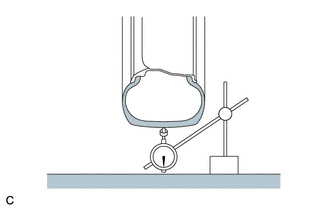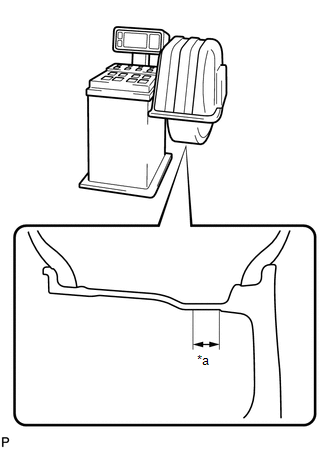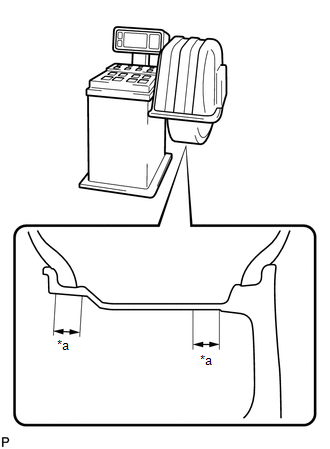| Last Modified: 05-13-2024 | 6.11:8.1.0 | Doc ID: RM100000002678V |
| Model Year Start: 2023 | Model: GR Corolla | Prod Date Range: [09/2022 - 11/2022] |
| Title: TIRE / WHEEL: TIRE AND WHEEL SYSTEM: INSPECTION; 2023 MY Corolla Corolla Hatchback Corolla HV GR Corolla [09/2022 - 11/2022] | ||
INSPECTION
PROCEDURE
1. INSPECT TIRES
(a) Inspect the tires for wear and proper inflation pressure.
Cold Tire Inflation Pressure (for Hatchback (except G16E-GTS)):
|
Tire Size |
Cold Tire Inflation Pressure |
|
|---|---|---|
|
Front |
Rear |
|
|
195/65R15 91S |
260 kPa (2.6 kgf/cm2, 38 psi) |
250 kPa (2.5 kgf/cm2, 36 psi) |
|
205/55R16 91H |
240 kPa (2.4 kgf/cm2, 35 psi) |
230 kPa (2.3 kgf/cm2, 33 psi) |
|
225/40R18 88V |
230 kPa (2.3 kgf/cm2, 33 psi) |
210 kPa (2.1 kgf/cm2, 30 psi) |
Cold Tire Inflation Pressure (for Hatchback (for G16E-GTS)):
|
Tire Size |
Cold Tire Inflation Pressure |
|
|---|---|---|
|
Front |
Rear |
|
|
235/40ZR18 (95Y) |
240 kPa (2.4 kgf/cm2, 35 psi) |
230 kPa (2.3 kgf/cm2, 33 psi) |
Cold Tire Inflation Pressure (for TMC Made Sedan):
|
Tire Size |
Cold Tire Inflation Pressure |
|
|---|---|---|
|
Front |
Rear |
|
|
*1: for Torsion Beam Type Suspension
*2: for Double Wishbone Type Suspension |
||
|
195/65R15 91S |
230 kPa (2.3 kgf/cm2, 33 psi)*1 260 kPa (2.6 kgf/cm2, 38 psi)*2 |
210 kPa (2.1 kgf/cm2, 30 psi)*1 250 kPa (2.5 kgf/cm2, 36 psi)*2 |
|
205/55R16 91H |
240 kPa (2.4 kgf/cm2, 35 psi) |
230 kPa (2.3 kgf/cm2, 33 psi) |
|
225/40R18 88V |
230 kPa (2.3 kgf/cm2, 33 psi) |
210 kPa (2.1 kgf/cm2, 30 psi) |
|
195/65R15 91H |
220 kPa (2.2 kgf/cm2, 32 psi) |
220 kPa (2.2 kgf/cm2, 32 psi) |
|
205/55R16 91V |
220 kPa (2.2 kgf/cm2, 32 psi) |
220 kPa (2.2 kgf/cm2, 32 psi) |
Cold Tire Inflation Pressure (for TMMMS Made Sedan):
|
Tire Size |
Cold Tire Inflation Pressure |
|
|---|---|---|
|
Front |
Rear |
|
|
195/65R15 91S |
260 kPa (2.6 kgf/cm2, 38 psi) |
250 kPa (2.5 kgf/cm2, 36 psi) |
|
205/55R16 91H |
240 kPa (2.4 kgf/cm2, 35 psi) |
230 kPa (2.3 kgf/cm2, 33 psi) |
|
225/40R18 88V 225/40R18 88W |
230 kPa (2.3 kgf/cm2, 33 psi) |
210 kPa (2.1 kgf/cm2, 30 psi) |
|
205/55R16 91V |
220 kPa (2.2 kgf/cm2, 32 psi) |
220 kPa (2.2 kgf/cm2, 32 psi) |
|
225/45R17 91W |
230 kPa (2.3 kgf/cm2, 33 psi) |
210 kPa (2.1 kgf/cm2, 30 psi) |
Cold Tire Inflation Pressure (for Compact Spare Tire):
|
Tire Size |
Cold Tire Inflation Pressure |
|---|---|
|
T125/70D17 98M |
420 kPa (4.2 kgf/cm2, 60 psi) |
(1) Perform initialization.
for Gasoline Model (for Type A): Click here
![2019 - 2023 MY Corolla Corolla Hatchback GR Corolla [06/2018 - 11/2022]; TIRE PRESSURE MONITORING: TIRE PRESSURE WARNING SYSTEM (for Gasoline Model (for Type A)): INITIALIZATION](/t3Portal/stylegraphics/info.gif)
for Gasoline Model (for Type B): Click here
![2023 - 2025 MY Corolla Corolla Hatchback GR Corolla [09/2022 - ]; TIRE PRESSURE MONITORING: TIRE PRESSURE WARNING SYSTEM (for Gasoline Model (for Type B)): INITIALIZATION](/t3Portal/stylegraphics/info.gif)
(2) Tire pressure adjustment method when warm:
- Turn the ignition switch (for Gasoline Model) or power switch (for HV Model) off.
- Connect the Techstream to the DLC3.
- Turn the ignition switch (for Gasoline Model) or power switch (for HV Model) on (IG).
- Turn the Techstream on.
- Enter the following menus: Chassis / Tire Pressure Monitor / Data List.
- Adjust the tire pressure so that the displayed value is equal to the set pressure.
- Perform initialization and check that initialization completes.
- Check and record the value of the Data List item "Temperature in Tire". (Ts)
- Check and record the ambient temperature during tire pressure adjustment. (Tm)
-
Readjust the tire pressure according to the difference between the tire internal temperature (Ts) and the ambient temperature (Tm). (P)
HINT:
Tire internal temperature: Ts, Ambient temperature: Tm, Tire pressure readjustment value: P
P = (Specified Pressure) + (Ts - Tm)
- Check the pressure adjustment value with the Data List item "Tire Inflation Pressure".
|
(b) Using a dial indicator, check the runout of the tires. Maximum Tire Runout: 1.4 mm (0.0551 in.) HINT: Measure the runout with the wheel assembly removed from the vehicle. |
|
2. ROTATE TIRES
(a) Remove the wheel assembly.
(b) except Mexico:
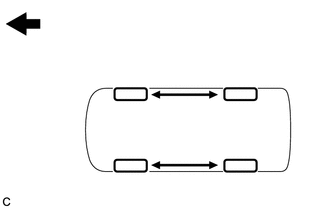

|
Front |
(1) Rotate the tires as shown in the illustration.
(c) for Mexico:
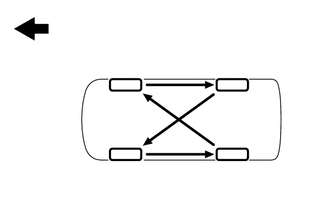

|
Front |
(1) Rotate the tires as shown in the illustration.
(d) Install the wheel assembly.
(e) Perform initialization.
for Gasoline Model (for Type A): Click here
![2019 - 2023 MY Corolla Corolla Hatchback GR Corolla [06/2018 - 11/2022]; TIRE PRESSURE MONITORING: TIRE PRESSURE WARNING SYSTEM (for Gasoline Model (for Type A)): INITIALIZATION](/t3Portal/stylegraphics/info.gif)
for Gasoline Model (for Type B): Click here
![2023 - 2025 MY Corolla Corolla Hatchback GR Corolla [09/2022 - ]; TIRE PRESSURE MONITORING: TIRE PRESSURE WARNING SYSTEM (for Gasoline Model (for Type B)): INITIALIZATION](/t3Portal/stylegraphics/info.gif)
3. INSPECT AND ADJUST WHEEL BALANCE
(a) Inspect and adjust the off-the-car balance.
(1) for Steel Wheel:
Maximum Wheel Imbalance:
8.0 g (0.0176 lb)
HINT:
- Use clip-on type balance weights for both the inner and outer side.
- If the tires vibrate even after the off-the-car balance adjustment, adjust the wheel balance with on-the-car balancing as necessary.
|
(2) for Alloy Wheel (except 18 inch): Maximum Wheel Imbalance: 8.0 g (0.0176 lb) NOTICE:
HINT:
|
|
|
(3) for Alloy Wheel (for 18 inch): Maximum Wheel Imbalance: 8.0 g (0.0176 lb) NOTICE:
HINT:
|
|
4. INSPECT FRONT AXLE HUB BEARING
5. INSPECT REAR AXLE HUB BEARING
for Double Wishbone Type Suspension 2WD with Electric Parking Brake: Click here
![2023 - 2025 MY Corolla Corolla Hatchback Corolla HV [09/2022 - ]; AXLE AND DIFFERENTIAL: REAR AXLE HUB (for Double Wishbone Type Suspension 2WD with Electric Parking Brake): ON-VEHICLE INSPECTION](/t3Portal/stylegraphics/info.gif)
for Double Wishbone Type Suspension 2WD without Electric Parking Brake: Click here
![2020 - 2023 MY Corolla Corolla Hatchback Corolla HV [01/2019 - 11/2022]; AXLE AND DIFFERENTIAL: REAR AXLE HUB (for Double Wishbone Type Suspension 2WD without Electric Parking Brake): ON-VEHICLE INSPECTION](/t3Portal/stylegraphics/info.gif)
for AWD with Electric Parking Brake: Click here
![2023 - 2025 MY Corolla Corolla Hatchback Corolla HV GR Corolla [09/2022 - ]; AXLE AND DIFFERENTIAL: REAR AXLE HUB (for AWD with Electric Parking Brake): ON-VEHICLE INSPECTION](/t3Portal/stylegraphics/info.gif)
for AWD without Electric Parking Brake: Click here
![2023 - 2025 MY Corolla Corolla Hatchback Corolla HV GR Corolla [09/2022 - ]; AXLE AND DIFFERENTIAL: REAR AXLE HUB (for AWD without Electric Parking Brake): ON-VEHICLE INSPECTION](/t3Portal/stylegraphics/info.gif)
for Torsion Beam Type Suspension: Click here
![2023 - 2025 MY Corolla Corolla Hatchback Corolla HV GR Corolla [09/2022 - ]; AXLE AND DIFFERENTIAL: REAR AXLE HUB (for Torsion Beam Type Suspension): ON-VEHICLE INSPECTION](/t3Portal/stylegraphics/info.gif)
|
|
|
